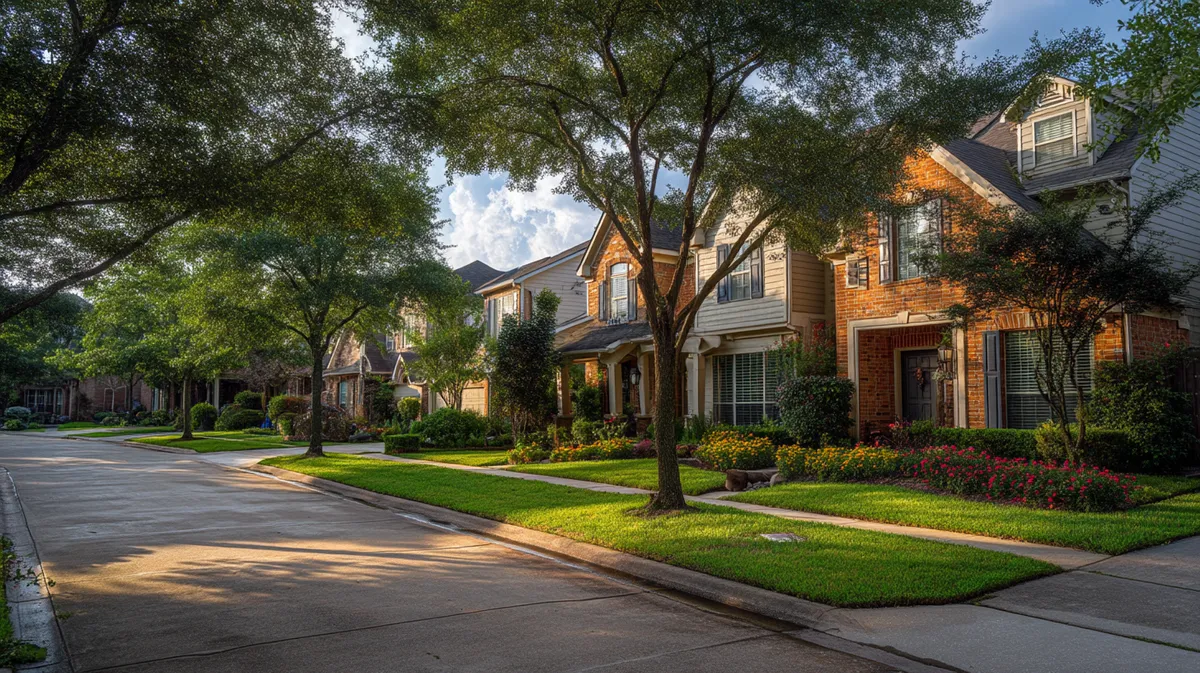Sitting on the south side of Clear Lake, about halfway between downtown Houston and the beaches of Galveston, League City mixes big-city access with a laid-back, boating-and-ball-fields vibe.
Housing, groceries, and day-to-day expenses clock a cost-of-living score of 95.8, which is roughly four percent below the U.S. average and a touch under the Texas average, so daily life feels manageable even as home prices inch past the statewide norm.
Median household income helps offset those costs; DataUSA puts League City’s median at about $119,870 a year, well above both state and national medians.
If you’re scrolling listings for homes for sale in League City, that paycheck-to-price balance sits right beside the safety conversation.
Crime Breakdown in League City
League City isn’t crime-free, but the numbers paint a calmer picture than many Gulf Coast suburbs of similar size.
The overall crime rate sits at 24.98 incidents per 1,000 residents in a typical year, and your odds of being a victim shift a lot from marina-side neighborhoods to the busier retail corridors.
Property Crime
Property offenses such as burglary, theft, vehicle theft, and arson add up to 14.98 per 1,000 residents. Theft makes up the bulk, followed by car break-ins. Burglaries trail well behind, and arson is rare.
Put differently, the chance of dealing with a property crime is about one in 67 each year, lower than in Houston’s core but high enough to keep porch-light timers and camera doorbells popular.
Violent Crime
Violent crime lands at 2.595 incidents per 1,000 residents. Assaults account for just over one per 1,000, robberies less than half that, and reported rapes sit just under one per 1,000.
Homicide remains uncommon, with rates under 0.1 per 1,000. Statistically, the odds of facing violent crime here hover around one in 385.
Other Crime
“Other” offenses, including drug cases, vandalism, identity theft, and kidnapping, total 7.41 per 1,000 residents.
Drug arrests dominate this category, followed by vandalism, while identity-theft complaints have ticked upward with more online shopping.
Trends in League City Crime Rates
A GoBankingRates study slotted League City among the ten safest and most affordable large U.S. cities, thanks to its below-average crime rate and moderate living costs.
Locals still talk about catalytic-converter theft spikes or summer car break-ins at boat ramps, but year-over-year totals haven’t surged.
Comparing Crime Rates
Texas overall reports 4.7 violent crimes and 28.4 property crimes per 1,000 people. League City comes in lower on both counts.
Nearby comparisons tell more of the story:
- Friendswood: violent 2.62; property 20.59 per 1,000 — similar violent rate but higher property risk.
- Dickinson: violent 4.33; property 22.15 per 1,000 — noticeably higher violent rate and slightly higher property.
- Webster: violent 6.19; property 31.89 per 1,000 — well above League City across the board.
For city residents comparing places to live, those stats underscore why League City’s crime rates feel more middle-of-the-road than worrisome.
Safety Measures and Resources
City ordinances require visible house numbers, outdoor lighting on new builds, and alarm permits that cut down on false-alarm fines.
HOAs run watch groups, marinas lock up with keyed gates, and nonprofits team with police for shred days and catalytic-converter etching clinics.
Role of the League City Police Department
The League City Police Department has around 170 officers on the roster, with units spread from Clear Lake marinas to the busy Gulf Freeway retail strip. A newer Business District Unit focuses on shoplifting and car break-ins around the malls, while patrol numbers rise in summer when regatta traffic crowds the bay.
Response times average under six minutes for high-priority calls, which is quick by regional standards. Between visible patrols, neighborhood watch support, and business outreach programs, the department aims to keep daily issues from growing into bigger problems.
Community Safety Initiatives
League City treats safety as a neighborhood effort, not just a police job. The Citizen Police Academy lets residents ride along with officers and sit in on mock investigations, giving a clearer picture of how local policing works.
Each fall, National Night Out turns cul-de-sacs into block parties with patrol cars parked beside food trucks and neighbors swapping stories with officers. Teens get their turn in the Teen Academy, a summer program with traffic-stop demos and K-9 units that breaks down barriers between young people and police.
On the practical side, events like shred days and catalytic-converter etching clinics may not grab headlines, but they quietly chip away at property crime and keep costs down for city residents.
Living in League City: Is it a Safe Place to Live?
League City’s overall crime rate of about 25 incidents per 1,000 residents sits below state averages and far below Houston’s urban core. Violent crime is low, property crime is moderate, and most other offenses tilt toward non-violent categories.
Keeping porch lights on, locking vehicles, and joining watch groups are still smart habits, but the data show League City is generally a safe place to live.
With ongoing community-policing efforts, the outlook suggests stability or gradual improvement over the next few years.
League City Safety FAQs
League City averages about 25 incidents per 1,000 residents each year, which puts it slightly above the national midpoint but still well below most large cities in Texas.
That means the day-to-day risk here feels manageable, especially compared to Houston just up the road.
Crime maps show the northwest side near retail corridors and freeway access points logging the highest number of reports. These areas tend to attract shoplifting, car break-ins, and traffic-related calls simply because more people pass through.
By contrast, the neighborhoods along Clear Lake and the east side closer to Kemah record far fewer incidents, making the location of your home an important factor in how safe things feel day to day
No, violent crime has actually been easing down in recent years. The FBI’s latest numbers showed a national decline in 2024, and League City mirrored that trend with small but steady drops in assaults and robberies.
While occasional incidents still make headlines, the overall trajectory has been positive rather than alarming.
Yes, the comparisons are clear when you look at the stats. Friendswood sees more property crime, Dickinson posts a higher violent crime rate, and Webster sits higher in both categories, giving League City the edge for people weighing nearby places to live.
Those numbers explain why many residents view League City as a safe middle ground between Houston’s intensity and the smaller surrounding towns.
Newcomers can plug into several local programs that build trust between residents and the police department.
The Citizen Police Academy runs sessions where you ride along with officers and see how calls are handled, while National Night Out brings whole neighborhoods together every fall for block parties with patrol cars and food trucks.
These events may feel casual, but they go a long way toward building connections and keeping League City’s crime rate from climbing higher.



